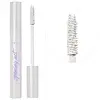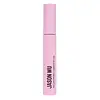What's inside
What's inside
 Key Ingredients
Key Ingredients

 Benefits
Benefits

 Concerns
Concerns

 Ingredients Side-by-side
Ingredients Side-by-side

Water
Skin ConditioningEthylene/Va Copolymer
Emulsion StabilisingCopernicia Cerifera Wax
Hydrogenated Olive Oil Stearyl Esters
Emulsion StabilisingGlyceryl Stearate
EmollientNylon-12
Cetearyl Stearate
Skin ConditioningStearic Acid
CleansingPalmitic Acid
EmollientTriethanolamine
BufferingSilica
AbrasiveHydrated Silica
AbrasivePhenoxyethanol
PreservativeHydroxyethylcellulose
Emulsion StabilisingHydrogenated Castor Oil
EmollientSynthetic Wax
AbrasiveCellulose
AbsorbentDimethicone
EmollientBabassu Oil Glycereth-8 Esters
EmulsifyingCetearyl Alcohol
EmollientAscorbyl Palmitate
AntioxidantEthylhexylglycerin
Skin ConditioningDisodium Phosphate
BufferingPolysorbate 60
EmulsifyingTocopherol
AntioxidantSodium Phosphate
BufferingWater, Ethylene/Va Copolymer, Copernicia Cerifera Wax, Hydrogenated Olive Oil Stearyl Esters, Glyceryl Stearate, Nylon-12, Cetearyl Stearate, Stearic Acid, Palmitic Acid, Triethanolamine, Silica, Hydrated Silica, Phenoxyethanol, Hydroxyethylcellulose, Hydrogenated Castor Oil, Synthetic Wax, Cellulose, Dimethicone, Babassu Oil Glycereth-8 Esters, Cetearyl Alcohol, Ascorbyl Palmitate, Ethylhexylglycerin, Disodium Phosphate, Polysorbate 60, Tocopherol, Sodium Phosphate
Water
Skin ConditioningAcrylates/Ethylhexyl Acrylate Copolymer
Synthetic Wax
AbrasiveStearic Acid
CleansingCetearyl Olivate
Hydrogenated Polyisobutene
EmollientCellulose
AbsorbentSorbitan Olivate
EmulsifyingParaffin
PerfumingCopernicia Cerifera Wax
Acacia Senegal Gum
MaskingPolysorbate 20
EmulsifyingPentaerythrityl Hydrogenated Rosinate
CI 77891
Cosmetic ColorantAcrylates/Octylacrylamide Copolymer
Ethylhexylglycerin
Skin ConditioningGlycerin
HumectantSorbitan Sesquioleate
EmulsifyingTromethamine
BufferingSilica
AbrasiveLaureth-21
CleansingHydroxyethylcellulose
Emulsion StabilisingDimethicone
EmollientArachidic Acid
CleansingPalmitic Acid
EmollientOleic Acid
EmollientPanthenol
Skin ConditioningUrea
BufferingDisodium Phosphate
BufferingBiotin
AntiseborrhoeicCitric Acid
BufferingAcetyl Hexapeptide-1
Skin ConditioningAcetyl Hexapeptide-8
HumectantAcetyl Tetrapeptide-3
Skin ProtectingAcetyl Tetrapeptide-9
Skin ConditioningCopper Tripeptide-1
Skin ConditioningPalmitoyl Pentapeptide-4
Skin ConditioningPalmitoyl Tetrapeptide-7
Skin ConditioningPalmitoyl Tripeptide-1
Skin ConditioningHexapeptide-11
Skin ConditioningBiotinoyl Tripeptide-1
Water, Acrylates/Ethylhexyl Acrylate Copolymer, Synthetic Wax, Stearic Acid, Cetearyl Olivate, Hydrogenated Polyisobutene, Cellulose, Sorbitan Olivate, Paraffin, Copernicia Cerifera Wax, Acacia Senegal Gum, Polysorbate 20, Pentaerythrityl Hydrogenated Rosinate, CI 77891, Acrylates/Octylacrylamide Copolymer, Ethylhexylglycerin, Glycerin, Sorbitan Sesquioleate, Tromethamine, Silica, Laureth-21, Hydroxyethylcellulose, Dimethicone, Arachidic Acid, Palmitic Acid, Oleic Acid, Panthenol, Urea, Disodium Phosphate, Biotin, Citric Acid, Acetyl Hexapeptide-1, Acetyl Hexapeptide-8, Acetyl Tetrapeptide-3, Acetyl Tetrapeptide-9, Copper Tripeptide-1, Palmitoyl Pentapeptide-4, Palmitoyl Tetrapeptide-7, Palmitoyl Tripeptide-1, Hexapeptide-11, Biotinoyl Tripeptide-1
Ingredients Explained
These ingredients are found in both products.
Ingredients higher up in an ingredient list are typically present in a larger amount.
Cellulose is the main component of plant cell walls. It is used as an emulsifier, absorbent, and texture enhancer.
This ingredient has many functions:
Fun fact: Cellulose is the most abundant form of organic polymer on Earth.
Learn more about CelluloseCopernicia Cerifera Wax comes from a palm tree native to Brazil; another name for this ingredient is Carnauba Wax.
This ingredient is used to thicken texture and also leaves behind a film when applied.
Fun fact: This wax has the highest melting point of all natural waxes and low solubility.
Learn more about Copernicia Cerifera WaxDimethicone is a type of synthetic silicone created from natural materials such as quartz.
What it does:
Dimethicone comes in different viscosities:
Depending on the viscosity, dimethicone has different properties.
Ingredients lists don't always show which type is used, so we recommend reaching out to the brand if you have questions about the viscosity.
This ingredient is unlikely to cause irritation because it does not get absorbed into skin. However, people with silicone allergies should be careful about using this ingredient.
Note: Dimethicone may contribute to pilling. This is because it is not oil or water soluble, so pilling may occur when layered with products. When mixed with heavy oils in a formula, the outcome is also quite greasy.
Learn more about DimethiconeDisodium Phosphate is a water-soluble powder used as a pH adjuster.
Ethylhexylglycerin (we can't pronounce this either) is commonly used as a preservative and skin softener. It is derived from glyceryl.
You might see Ethylhexylglycerin often paired with other preservatives such as phenoxyethanol. Ethylhexylglycerin has been found to increase the effectiveness of these other preservatives.
Hydroxyethylcellulose is used to improve the texture of products. It is created from a chemical reaction involving ethylene oxide and alkali-cellulose. Cellulose is a sugar found in plant cell walls and help give plants structure.
This ingredient helps stabilize products by preventing ingredients from separating. It can also help thicken the texture of a product.
This ingredient can also be found in pill medicines to help our bodies digest other ingredients.
Learn more about HydroxyethylcellulosePalmitic Acid is a fatty acid naturally found in our skin and in many plant and animal sources. In cosmetics, it is usually derived from palm oil. It serves many purposes in skincare, acting as a cleanser, emollient, and emulsifier.
As an emollient, palmitic acid helps soften and smooth the skin by preventing water loss. In cleansers, it helps remove oil and dirt while creating foam.
Its emulsifying properties help stabilize products by keeping water and oil-based ingredients from separating.
This may not be suitable for fungal acne-prone skin, as fatty acids like this can sometimes trigger breakouts in sensitive individuals.
Learn more about Palmitic AcidSilica, also known as silicon dioxide, is a naturally occurring mineral. It is used as a fine, spherical, and porous powder in cosmetics.
Though it has exfoliant properties, the function of silica varies depending on the product.
The unique structure of silica enhances the spreadability and adds smoothness, making it a great texture enhancer.
It is also used as an active carrier, emulsifier, and mattifier due to its ability to absorb excess oil.
In some products, tiny microneedles called spicules are made from silica or hydrolyzed sponge. When you rub them in, they lightly polish away dead skin layers and enhance the penetration of active ingredients.
Learn more about SilicaStearic Acid is a fatty acid. It is an emollient, emulsifier, and texture enhancer.
As an emollient, stearic acid helps soften skin. It aids the skin's protective barrier by preventing water loss. It also provides a gentle cleansing effect without stripping away natural oils.
Stearic acid may also be used to enhance the texture of products. It can add volume and stabilize ingredients such as water and oil. This can help water and oil ingredients from separating.
Sources of stearic acid include animal or vegetable fats/oils such as coconut or shea. It can be naturally found in butter, cocoa butter, shea butter, vegetable fats, and animal tallow.
This ingredient may not be Malassezia folliculitis, or fungal-acne safe.
Learn more about Stearic AcidSynthetic Wax is created from fossil fuels such as natural gas. It is used to enhance texture, adjust pH, and as an occlusive.
It may also be used as an abrasive ingredient to exfoliate the skin.
Synthetic Wax may not be fungal acne safe.
Learn more about Synthetic WaxWater. It's the most common cosmetic ingredient of all. You'll usually see it at the top of ingredient lists, meaning that it makes up the largest part of the product.
So why is it so popular? Water most often acts as a solvent - this means that it helps dissolve other ingredients into the formulation.
You'll also recognize water as that liquid we all need to stay alive. If you see this, drink a glass of water. Stay hydrated!
Learn more about Water